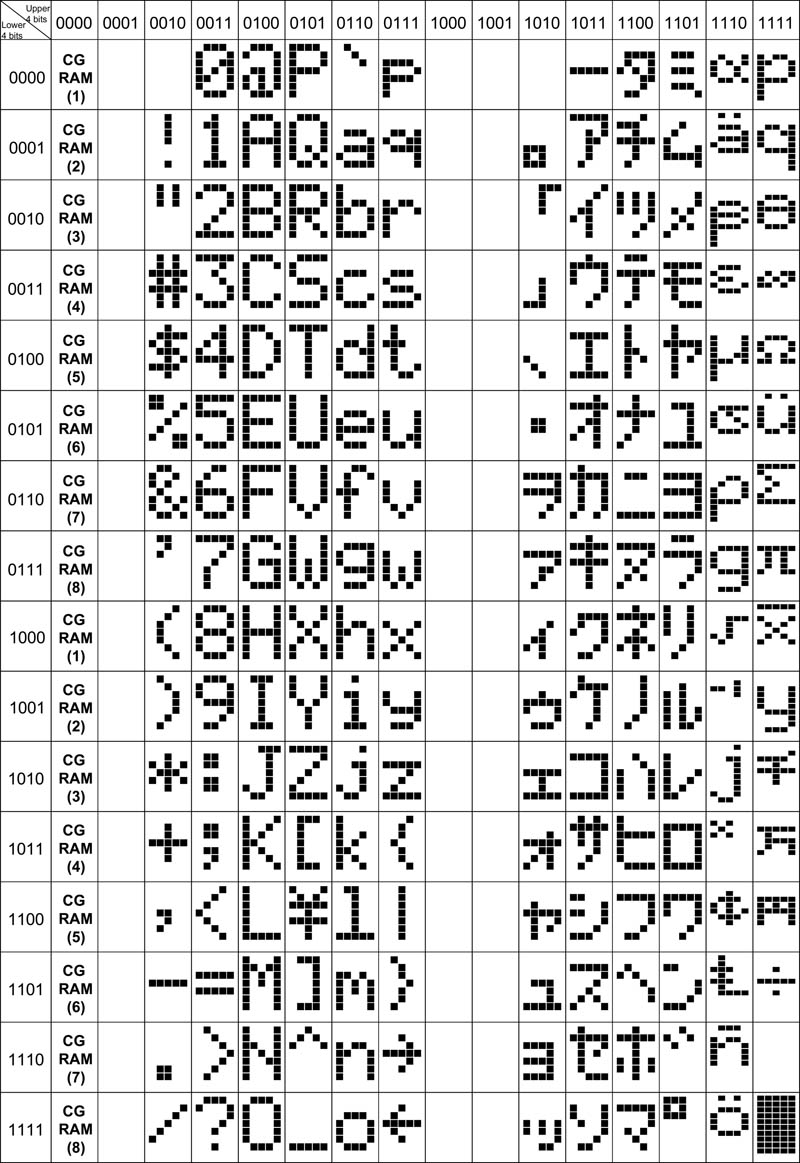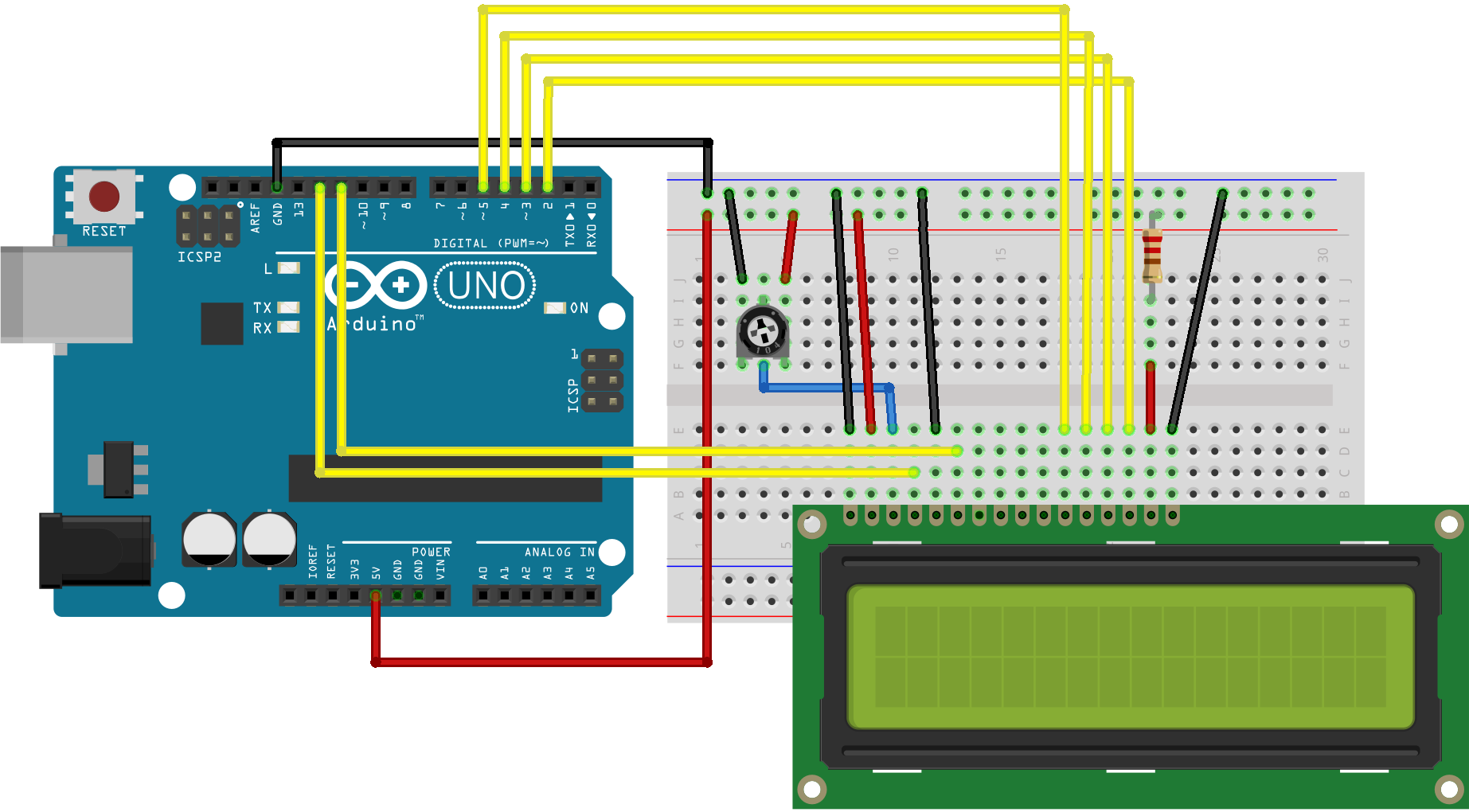4-Bit Hd44780 Lcd Display Driver
The Hitachi HD44780 LCD controller is limited to monochrome text displays and is often used in, industrial test equipment, networking equipment, such as and. Compatible LCD screens are manufactured in several standard configurations. Common sizes are one row of eight characters (8x1), and 16×2, 20×2 and 20×4 formats. Larger custom sizes are made with 32, 40 and 80 characters and with 1, 2, 4 or 8 lines. The most commonly manufactured larger configuration is 40x4. Characters, which requires two individually addressable HD44780 controllers with expansion chips as a single HD44780 chip can only address up to 80 characters.
A common smaller size is 16×2, and this size is readily available as surplus or new stock for hobbyist and prototyping work. Character LCDs may have a, which may be,. Character LCDs use a 16 contact interface, commonly using pins or card edge connections on 0.1 inch (2.54 mm) centers. Those without backlights may have only 14 pins, omitting the two pins powering the light. This interface was designed to be easily hooked up to the MCS-51 XRAM interface, using only two address pins, which allowed displaying text on LCD using simple MOVX commands, offering cost effective option for adding text display to devices. The pinout is as follows. Amber backlight on a HD44780 display.
Ground. VCC (+3.3 to +5V). Contrast adjustment (VO). Register Select (RS). RS=0: Command, RS=1: Data. Read/Write (R/W).

R/W=0: Write, R/W=1: Read (This pin is optional due to the fact that most of the time you will only want to write to it and not read. Therefore, in general use, this pin will be permanently connected directly to ground.). Clock (Enable). Falling edge triggered. Bit 0 (Not used in 4-bit operation). Bit 1 (Not used in 4-bit operation). Bit 2 (Not used in 4-bit operation).
Bit 3 (Not used in 4-bit operation). Bit 4. Bit 5.
Bit 6. Bit 7. Backlight Anode (+) (If applicable). Backlight Cathode (-) (If applicable) The nominal operating voltage for LED backlights is 5V at full brightness, with dimming at lower voltages dependent on the details such as LED color.
Non-LED backlights often require higher voltages. Mode Selection Selecting 4-bit or 8-bit mode requires careful selection of commands. There are two primary considerations. First, with D3-D0 unconnected, these lines will always appear low (0b0000) to the HD44780 when it is in 8-bit mode.
Second, the LCD may initially be in one of three states:. (State1) 8-bit mode. (State2) 4-bit mode, waiting for the first set of 4 bits. (State3) 4-bit mode, waiting for the second set of 4 bits State3 may occur, for example, if a prior control was aborted after sending only the first 4 bits of a command while the LCD was in 4-bit mode. The following algorithm ensures that the LCD is in the desired mode:. Set D7-D4 to 0b0011, and toggle the enable bit. If in State1, the LCD will see the command as 0b00110000, and thus remain in 8-bit mode (State1).
If in State2, the LCD will simply latch the value 0b0011 into bits 7-4 and then move to State3. If in State3, the LCD will latch the value 0b0011 into bits 3-0, and then execute a random command based on the (unknown to us) values in bits 7-4, after which it will either be in State1 (if the unknown bits happened to be 0b0011), or State2 (if the unknown bits were anything else). Repeat the above, setting D7-D4 to 0b0011 and toggling the enable bit again. If in State1, the LCD will remain in 8-bit mode (State1) just as above. If in State2, it will latch the value into bits 7-4 and move to State3, just as above. If in State3, the LCD will latch the value into bits 3-0 just as above and execute a command. However, the command will no longer be random, but will be the 0b0011 that was latched from State2 in the previous iteration.
Thus, the LCD will switch to 8-bit mode and change to State1. The LCD is now in either State1 or State 3. Repeat the previous step one more time. If in State1, the LCD will remain in 8-bit mode (and thus State1). The LCD can no longer be in State2 at this point. If in State3, the LCD will latch the value into bits 3-0 and execute a command, which will be the 0b0011 that was latched from State2 in the previous iteration, thus switching the LCD to 8-bit mode and State1. Now that the LCD is definitely in 8-bit mode, it can be switched to 4-bit mode if desired.
To do so, set D7-D4 to 0b0010 and toggle the enable bit. This will leave the LCD in 4-bit mode, configured for a single line and 5x8 fonts. Issue any desired additional Function Set commands to specify the number of lines and the font to use, being sure to use the appropriate value for bit 4 so as to remain in the desired mode (0 for 4-bit and 1 for 8-bit). Once in 4-bit mode, character and control data are transferred as pairs of 4-bit 'nibbles' on the upper data pins, D7-D4. The four most significant bits (7-4) must be written first, followed by the four least significant bits (3-0). Instruction set. The HD44780 instruction set is shown below: HD44780U based instruction set Instruction Code Description Execution time (max) (when f cp = 270 kHz) RS R/W B7 B6 B5 B4 B3 B2 B1 B0 Clear display 0 0 0 0 0 0 0 0 0 1 Clears display and returns cursor to the home position (address 0).

1.52 ms Cursor home 0 0 0 0 0 0 0 0 1. Returns cursor to home position. Also returns display being shifted to the original position. DDRAM content remains unchanged. 1.52 ms Entry mode set 0 0 0 0 0 0 0 1 I/D S Sets cursor move direction (I/D); specifies to shift the display (S). These operations are performed during data read/write. 37 μs Display on/off control 0 0 0 0 0 0 1 D C B Sets on/off of all display (D), cursor on/off (C), and blink of cursor position character (B).
37 μs Cursor/display shift 0 0 0 0 0 1 S/C R/L. Sets cursor-move or display-shift (S/C), shift direction (R/L). DDRAM content remains unchanged. 37 μs Function set 0 0 0 0 1 DL N F.
Sets interface data length (DL), number of display line (N), and character font (F). 37 μs Set CGRAM address 0 0 0 1 CGRAM address Sets the CGRAM address. CGRAM data are sent and received after this setting. 37 μs Set DDRAM address 0 0 1 DDRAM address Sets the DDRAM address. DDRAM data are sent and received after this setting.
37 μs Read busy flag & address counter 0 1 BF CGRAM/DDRAM address Reads busy flag (BF) indicating internal operation being performed and reads CGRAM or DDRAM address counter contents (depending on previous instruction). 0 μs Write CGRAM or DDRAM 1 0 Write Data Write data to CGRAM or DDRAM. 37 μs Read from CG/DDRAM 1 1 Read Data Read data from CGRAM or DDRAM. 37 μs Instruction bit names — I/D - 0 = decrement cursor position, 1 = increment cursor position; S - 0 = no display shift, 1 = display shift; D - 0 = display off, 1 = display on; C - 0 = cursor off, 1 = cursor on; B - 0 = cursor blink off, 1 = cursor blink on; S/C - 0 = move cursor, 1 = shift display; R/L - 0 = shift left, 1 = shift right; DL - 0 = 4-bit interface, 1 = 8-bit interface; N - 0 = 1/8 or 1/11 duty (1 line), 1 = 1/16 duty (2 lines); F - 0 = 5×8 dots, 1 = 5×10 dots; BF - 0 = can accept instruction, 1 = internal operation in progress. The original HD44780 character generator ROM contains 208 characters in a 5×8 dot matrix, and 32 characters in a 5×10 dot matrix. More recent compatible chips are available with higher resolution, matched to displays with more pixels. Two versions of the ROM have been developed:.
HD44780UA00, the standard version, which includes characters and some and. HD44780UA02, a version, which includes the complete set of Greek, and characters (with ) The 7-bit subset for the Japanese version is non-standard: it supplies a where the character is normally found, and left and right in place of and the.
A limited number of custom characters can be programmed into the device in the form of a using special commands. These characters have to be written to the device each time it is switched on, as they are stored in.
Hd44780 Controller
What we really need to know is: 1. The specific display that you are using.
The specific version of the Arduino IDE that you are using. The specific library that you are using. ALL of the connections to your display (did you connect pins 3 and 5?).
ALL of the code that you are using. The exact contents of the display that resulted (did the quotation marks and exclamation point really disappear?). How you managed to get 22 characters displayed on a 20 character wide display. Then we may be able to give some specific help. What we really need to know is: 1. The specific display that you are using. The specific version of the Arduino IDE that you are using.
The specific library that you are using. ALL of the connections to your display (did you connect pins 3 and 5?). ALL of the code that you are using. The exact contents of the display that resulted (did the quotation marks and exclamation point really disappear?). How you managed to get 22 characters displayed on a 20 character wide display. Then we may be able to give some specific help.